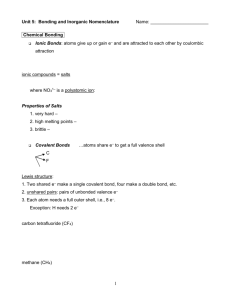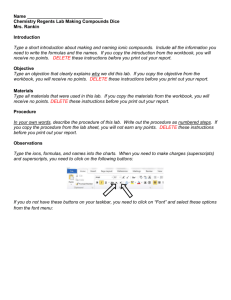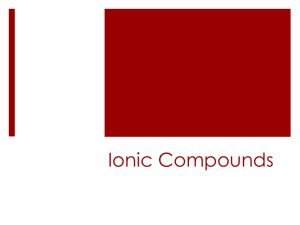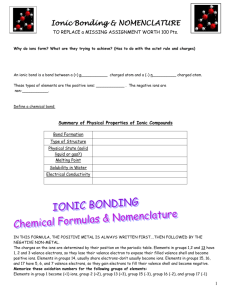Ionic Nomenclature notes
advertisement
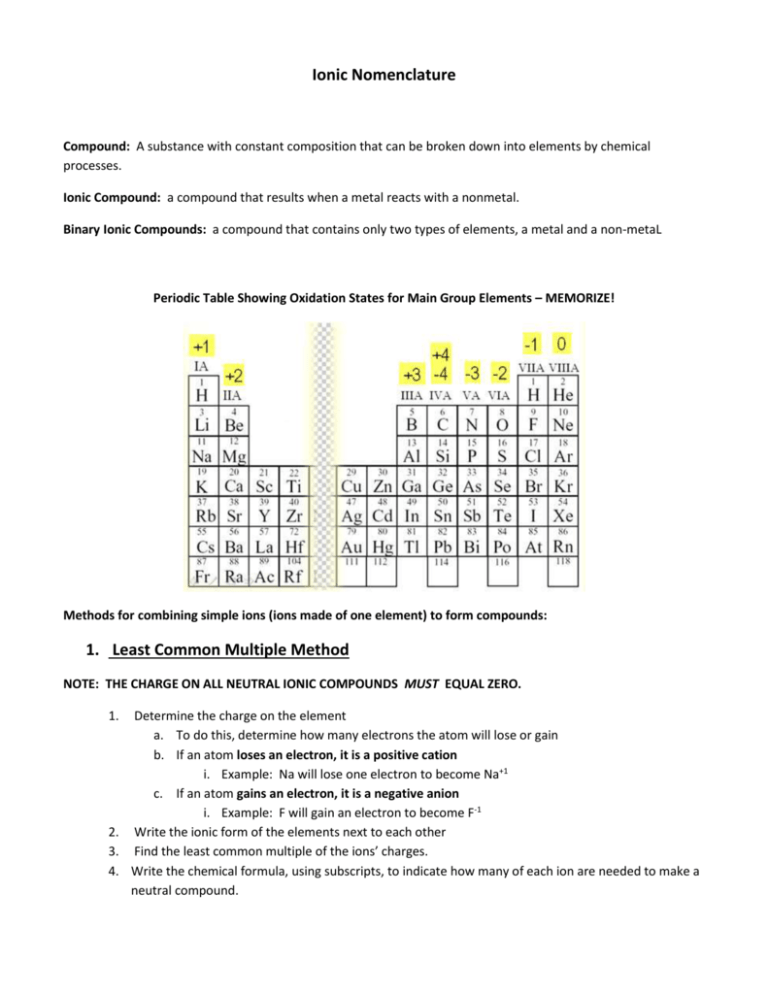
Ionic Nomenclature Compound: A substance with constant composition that can be broken down into elements by chemical processes. Ionic Compound: a compound that results when a metal reacts with a nonmetal. Binary Ionic Compounds: a compound that contains only two types of elements, a metal and a non-metaL Periodic Table Showing Oxidation States for Main Group Elements – MEMORIZE! Methods for combining simple ions (ions made of one element) to form compounds: 1. Least Common Multiple Method NOTE: THE CHARGE ON ALL NEUTRAL IONIC COMPOUNDS MUST EQUAL ZERO. 1. Determine the charge on the element a. To do this, determine how many electrons the atom will lose or gain b. If an atom loses an electron, it is a positive cation i. Example: Na will lose one electron to become Na+1 c. If an atom gains an electron, it is a negative anion i. Example: F will gain an electron to become F-1 2. Write the ionic form of the elements next to each other 3. Find the least common multiple of the ions’ charges. 4. Write the chemical formula, using subscripts, to indicate how many of each ion are needed to make a neutral compound. Example: Write the formula for the compound formed by lithium and phosphorous. 1. Write the ionic forms of the elements next to each other. Li1 2. P-3 Find the least common multiple of the ion’s charges. The least common multiple of 1 and 3 is 3. To get a neutral compound, you need a total of three positive charges and three negative charges. To get three positive charges, you need three Li+1 ions because 3 x 1 = +3 To get three negative charges, you need one P-3 ions because 1 x 3 = -3. 3. Write the chemical formula, using subscripts to indicate how many of each ion are needed to make a neutral compound: Li3P 2. Criss-Cross Method: NOTE: THE CHARGE ON ALL NEUTRAL IONIC COMPOUNDS MUST EQUAL ZERO. 1. 2. 3. 4. 5. Determine the charge on the element a. To do this, determine how many electrons the atom will lose or gain b. If an atom loses an electron, it is a positive cation i. Example: Na will lose one electron to become Na+1 c. If an atom gains an electron, it is a negative anion i. Example: F will gain an electron to become F-1 Write the ions next to each other. Criss cross the oxidation state of one element as the subscript on the other element. NOTE: A subscript of 1 is not written; it is understood. WRITE SUBSCRIPTS IN LOWEST TERMS. Rules for naming binary ionic compounds: 1. 2. 3. The cation is always named first and the anion is always named second. The simple cation keeps its elemental name. The name of the simple anion is named by taking the first part of the element name and changing the ending to “ide.” Combine the following elements to make ionic compounds and then name them. Sodium + Fluorine Lithium + Phosphorus Name: Lithium + Chlorine Name: Magnesium + Sulfur Name: Potassium + Bromine Name: Calcium + Oxygen Name: Rubidium + Iodine Name: Aluminum + Nitrogen Name: Magnesium + Chlorine Name: Potassium + Sulfur Name: Calcium + Fluorine Name: Sodium + Chlorine Name: Strontium + Iodine Name: Barium + oxygen Name: Sodium + Oxygen Name: Calcium + Nitrogen Name: Name: Ionic Bonding Ionic bonding occurs when a metal transfers one or more electrons to a nonmetal in an effort to attain a stable outer configuration (full valence configuration) of electrons. For example, the transfer of an electron from sodium to chlorine can be depicted by a Lewis Diagram: Na + Cl Calcium would need two chlorine atoms to get rid of its two valence electrons and achieve a full valence configuration: Ca + Cl Electron configuration method: Write out the Noble gas core configuration for both atoms: Na + Cl Ca + Cl For each of the following show: 1. Lewis Dot Diagram of bonding 2. Electron configuration diagram of bonding Sodium + Fluorine Lewis Dot: Calcium + Oxygen Lewis Dot Electron Configuration Electron Configuration Polyatomic Ions Polyatomic ion: group of atoms of different elements held together with a net charge. Consider it as you would a single cation or anion. MEMORIZE THE TABLE OF COMMON POLYATOMIC IONS (ATTACHED). Writing formulas with polyatomic ions: 1. Use any of the ionic combining methods learned above. 2. Make sure to write the cation first then the anion. 3. Place polyatomic ions in parentheses if there is more than one of them 4. To name: use the full name of the element and the names listed above. Example using the criss-cross method: Transition Metal Ionic Compounds

